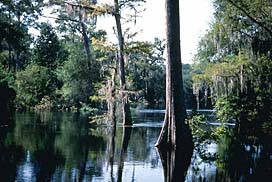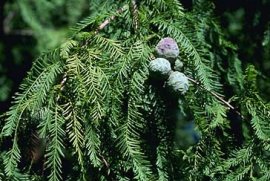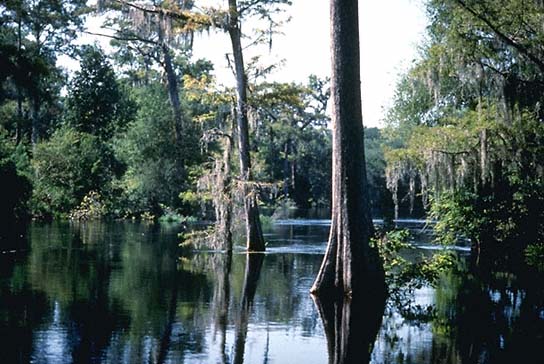Conifer Trees
Description
Large, needle-leaf, aquatic,
deciduous tree often with cone-shaped "knees" projecting from
submerged roots, with trunks enlarged at base and spreading into
ridges or buttresses, and with a crown of widely spreading branches,
flattened at top.
Height: 100-120' (30-37 m) or
more.
Diameter: 3-5' (0.9-1.5 m) , rarely 10' (3 m) or
more.
Needles: deciduous; 3/8-3/4" (10-19 mm) long. Borne singly
in 2 rows on slender green twigs, crowded and featherlike; flat,
soft, and flexible. Dull light green above, whitish beneath; turning
brown and shedding with twig in fall.
Bark: brown or gray; with
long fibrous or scaly ridges, peeling off in strips.
Cones:
3/4-1" (2-2.5 cm) in diameter; round; gray; 1-2 at end of twig;
several flattened, 4-angled, hard cone-scales shed at maturity in
autumn; 2 brown, 3-angled seeds nearly 1/4" (6 mm) long, under
cone-scale. Tiny pollen cones in narrow drooping cluster 4" (10 cm)
long.
Habitat
Very wet, swampy soils of riverbanks and floodplain lakes that are sometimes submerged; often in pure stands.
Discussion
Called the "wood eternal" because of the heartwood's resistance to decay, Bald Cypress is used for heavy construction, including docks, warehouses, boats, bridges, as well as general millwork and interior trim. The trees are planted as ornamentals northward in colder climates and in drier soils. Easily seen in Big Cypress National Preserve near Naples, Florida. Pond Cypress (var. nutans(Ait.) Sweet), a variety with shorter scalelike leaves, is found in shallow ponds and poorly drained areas from southeastern Virginia to southeastern Louisiana below 100' (30 m).




